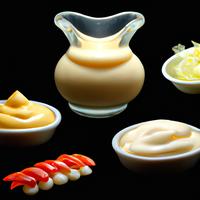
1 serving (15 grams) contains 100 calories, 0.2 grams of protein, 11.0 grams of fat, and 0.5 grams of carbohydrates.

Log this food in SnapCalorie

Nutrition Information
Calories |
1572.3 | ||
|---|---|---|---|
% Daily Value* |
|||
| Total Fat | 173.0 g | 221% | |
| Saturated Fat | 23.6 g | 118% | |
| Polyunsaturated Fat | 0 g | ||
| Cholesterol | 157.2 mg | 52% | |
| Sodium | 1415.1 mg | 61% | |
| Total Carbohydrates | 7.9 g | 2% | |
| Dietary Fiber | 0 g | 0% | |
| Sugars | 1.6 g | ||
| protein | 3.1 g | 6% | |
| Vitamin D | 0 mcg | 0% | |
| Calcium | 78.6 mg | 6% | |
| Iron | 1.6 mg | 8% | |
| Potassium | 78.6 mg | 1% | |
* Percent Daily Values are based on a 2,000 calorie diet. Your daily values may be higher or lower depending on your calorie needs.
Food Attributes
Source of Calories
About Japan mayonese
Japanese mayonnaise, often branded as Kewpie in Japan, is a creamy and tangy condiment with origins in Japanese cuisine. Unlike Western mayonnaise, it uses only egg yolks for a richer texture and combines them with vinegar—typically rice or apple cider—and a touch of mustard, creating its signature umami flavor. Additionally, Japanese mayonnaise often incorporates monosodium glutamate (MSG) as a flavor enhancer, contributing to its savory taste. While it’s celebrated for its depth of flavor, the condiment is calorie-dense due to its high fat content from vegetable oil and egg yolks. It is a source of vitamin E and contains some beneficial fats, but moderation is key for health-conscious individuals. Japanese mayonnaise is popularly used in dishes like okonomiyaki, takoyaki, and sushi, bringing a unique creaminess to traditional and modern recipes worldwide.



